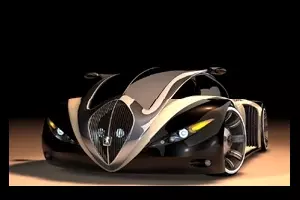My vision of what is known today as retro-futurism, its scope and concretions in success.
 The photo shows the Lion by Stefan Schulze, winner of the Peugeot Retro-Futurism contest.
The photo shows the Lion by Stefan Schulze, winner of the Peugeot Retro-Futurism contest.
The relationship between the human being and the car is much more complex than it seems. It arouses ambitions, passions, even nostalgia, but rarely indifference. There are those who say that a good car is the one that transports them comfortably to destination, minimize attention to the brand or model of the car, but still, they always have some opinion about their experiences in the different cars in which they have traveled.
The retro-futuristic design is an effort to capture people with different criteria, collecting elements that were distinctive and characteristic of the 1950s and 1960s mainly. The central idea is to bring those features from the past into the future, to what is to come in terms of new styling trends.
This type of design looks almost exclusively in “concept cars”, since mass production cars with retro characteristics, bring only elements that distinguished previous models, which were successful and remain present in the memory of the consumer market. They do not show any projection to the future, if it is clear that the styles merge.
A very important reason for the design to be retro and not retro-futuristic is the safety of insertion in the market. Earlier I mentioned that in such designs successful elements are taken in the past, that means that the public already accepted it once, and will do it again.
The difference with the projection to the future is that innovation, as far as design of forms is concerned, is judged with great subjectivity, therefore, it is not feasible to ensure 100% success. These concepts will help you understand why cars that are marketed today tend to have too many features in common, to the point where they make it difficult to distinguish between the company that manufactures each product.
What one sells because it is “fashionable”, will also be sold by the other manufacturer for the same cause. It should be noted that sometimes we see very similar vehicles in appearance, not for the reason recently mentioned, but because they share platforms with the aim of drastically reducing production costs, such is the case in Europe between BMW and Rover, Renault and Nissan, or in the USA. Chevrolet, Pontiac and Oldsmobile.
As a conclusion, I base my point of view: retro-futurism is another way of globalisation. It seeks to standardize and lay the basis of choice criteria, so that the customer still has the right to choose between different manufacturers.
Unfortunately, what it does not have is diversity, there is no possibility of achieving anything other than what large corporations impose as a product that theoretically meets the needs of that client. To conclude, what in principle may seem to be a strict matter of formal design is actually much deeper, and it contemplates a wide spectrum of cultural factors involved.
© Adrián Blanco 2004 — Prohibited the total or partial reproduction of text and/or images without explicit written consent of the author. —